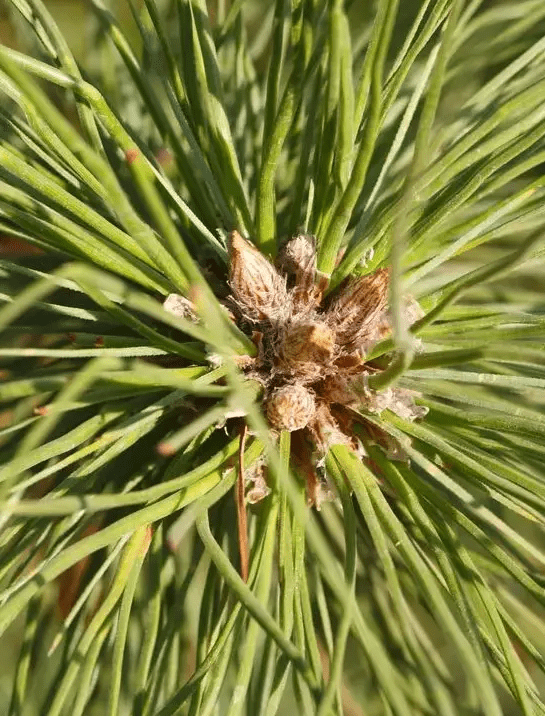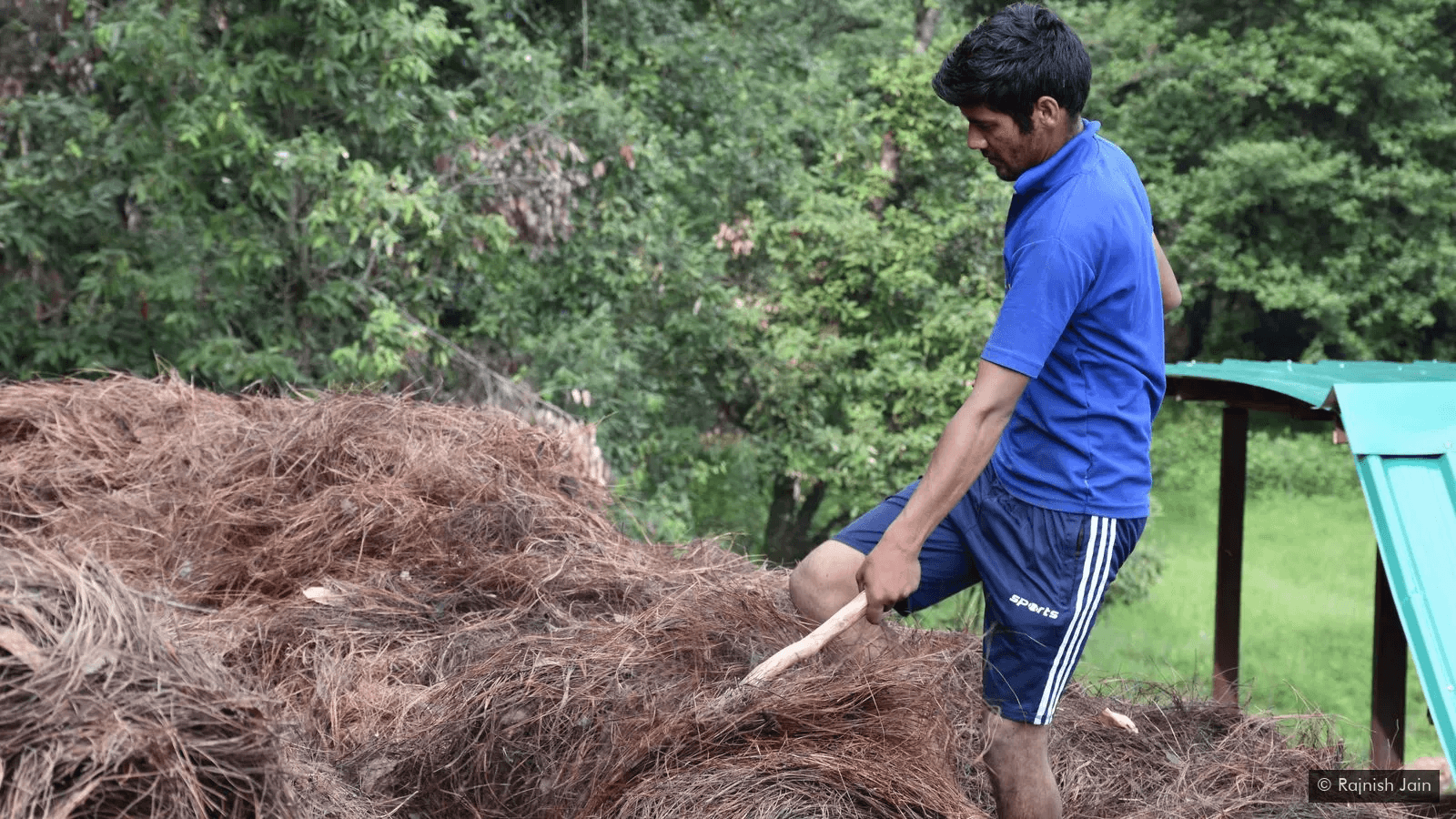
In Uttarakhand, in the western Himalayas, a local inventor discovered an unusual use for pine needles that is reviving the local economy, and the forest floor.
A nippy November morning saw me driving along mountain road in Tripuradevi village in India’s Pithoragarh district, Uttarakhand, with the warm sun peeping through the tall pines lining the road.
I was there to buy hand-woven organically dyed silks and cottons created by Avani, a community organisation employing local craftsmen and providing them with a steady source of income, alongside that from the surplus crops and produce they sell. But what caught my eye were heaps of pine needles drying in the sun. A man was feeding the dried pine needles into a large gently humming metal cylinder attached to more chambers and motor.
The set up, I was told, was a power plant to generate electricity from pine needles.
Uttarakhand, also known as Dev Bhoomi or “land of gods” for its many pilgrimage centres, is an Indian state in the western arm of the Himalayas, bordering
The loss of natural wealth translates into much more than a monetary one for our socio-cultural fabric – GCS Negi
One study estimates the net annual pine needle yield in the state of Uttarakhand to be some 1.3 million tonnes (that’s roughly a quarter of the weight of Great Pyramid of Giza). Pine needles shed by the trees between March to June cover the hill slopes, which are prone to fire.
Though forest fires play an ecological role, they also bring some inestimable losses. It challenges the make-up of the forest, says GCS Negi, head of the Centre for Socioeconomic Development at the GB Pant National Institute of Himalayan Environment. The fire renders the forest floor inhospitable to the region’s some 1,800 plants used as medicinal herbs, as well as indigenous grasses and broadleaf species such as Himalayan oak.
“Indigenous plants and trees are valuable ecologically and socially as they conserve soil and water, thus allowing rich biodiversity of wild edibles and minor forest produce that are used by locals,” says Negi. “The loss of natural wealth translates into much more than a monetary one for our socio-cultural fabric.”

He realised that it could be a way to fix several problems at once: as well as reducing the damage from fires, electricity produced from the needles could supplement or replace cooking fuel, which had to be bought in. He hoped it could even help to prevent migration away from the region, as a lack of reliable income from agriculture had forced people from the village to seek more lucrative employment in towns and cities. With this in mind, he began to research using pine needles as a fuel source for a type of energy production called biomass gasification.
The villagers thought I was out of my mind… generating electricity from pine needles seemed an alien concept – Rajnish Jain
This technology had started to gain traction in India in 1994, when the engineer S Dasappa and his team at the Indian Institute of Science, Bangalore started working on improving biomass gasifiers in collaboration with the engineering company Dasag, based in Switzerland. They experimented not with pine needles, but with agricultural waste like rice husks, leaves and coconut shells as feedstock, heated to over 1,000C in a reduced oxygen environment. In those conditions, the needles gave off a mixture of gases, including carbon monoxide, methane and hydrogen. These gases were further cleaned of dust and tar and burned to power an electric generator.
Dasappa’s design has since been improved further and patented. There are currently about 30 units operating in villages of Karnataka, India. “With abundant agricultural and forest biomass available in India, it is a low-cost energy source that has lower impact on the environment than fossil fuels,” says Dasappa. It has caught on elsewhere too, with uptake in countries including United States, Switzerland and Japan.
But Rajnish says his suggestion to utilise pine needles for biomass gasification was met with resistance and rejection from government officials and researchers at the time in 2007. They argued that even though highly combustible, the density of pine needles was not enough to be used as an energy source for gasification. They were not the only ones with questions. “The villagers thought I was out of my mind,” recalls Rajnish. “They did not know about biomass gasification, and generating electricity from pine needles seemed an alien concept.”
The idea, however, intrigued the Volkart Foundation, set up by Swiss brothers in 1953 to support NGOs working for poor communities, and they invested in the pine needle experiment. A few trials later, Rajnish struck on the idea of chopping the pine needles into smaller pieces to increase the density before feeding to the gasifier – and it worked. In 2009, he succeeded in setting up the world’s first 9 kWh pine needle power plant. Today, the electricity generated by the small plant is used to power the Avani workshop, while leftover carbon powder produced is bound together with locally made glue and made into briquettes to burn as a sustainable form of cooking fuel.

Encouraged by his success, Rajnish participated in many accelerator programmes to pitch his work and pursued support from government agencies. He believed his venture could provide a sustainable livelihood for villagers and, he hoped, reduce forest fires if rolled out on a large scale. It led to the setting up of Avani Bio Energy, a for-profit social enterprise, in 2011.
Avani Bio Energy then signed an agreement with the state electrical facility, which under national policy was required to source a percentage of its energy from renewable sources. By 2014, a policy on the commercial use of pine needles, including for gasification among other purposes, was brought into effect by the Uttarakhand Renewable Energy Development Agency.
But there were hurdles to rolling the project out on a large scale. The mountainous terrain in the region makes it challenging to collect pine needles. With unmotorable slopes, pine needles could only be collected manually. For every 1 kWh generated, 1.5 kilos of pine needles are required. An ambitious 120 kWh plant would require a huge amount of feedstock. So, they thought again and decided instead to install smaller decentralised power plants of 10-25 kWh each, so the volume of pine needles needed could be met with manual collection.
The village women, who Rajnish approached to collect needles, were initially hesitant. But each kilo of needles brought to the plant fetched 2 rupees (3 cents/2 pence), which over 6-7 hours’ work amounted to double the typical minimum daily wage for the state.
Asha Devi, a needle collector from Hasyudi village who has been collecting pine needles for three years, now has a very different view of the project. “I earned 8,000 rupees ($110/£85) in the first year and bought a buffalo for milk,” she says. This year she has earned up to 17,000 rupees ($230/£180) in one month. With her savings from last year, she constructed an additional room in her house and plans to add a kitchen next year. “It is convenient as I finish my house chores before I go for needle collection,” she says.

There are now seven 25 kWh power plants up and running at different villages, with five of those owned by village-based entrepreneurs, with a further five 10 kWh plants in other villages. Forty more projects are on the horizon.
As well as boosting the local economy, Rajnish hopes that the collection of pine needles has lowered the local fire risk. In the nearby areas that have seen consistent removal of pine needles, there has been almost no incidence of fire, he says.
The indigenous medicinal plants, usually destroyed by fires, have also been seen reviving. If the optimal conditions for these plants are maintained, some native plant species could begin to regenerate, says the GB Pant National Institute of Himalayan Environment’s Negi.
This year, the shoots of the kafal, or bay berry, have been seen emerging in Tripuradevi. The golden Himalayan raspberry and the Himalayan oak are also cropping up. They are a sign of what can happen when something seen as little more than a nuisance and a fire risk is put to good use, rejuvenating the forest floor and bringing hope to the local community.

